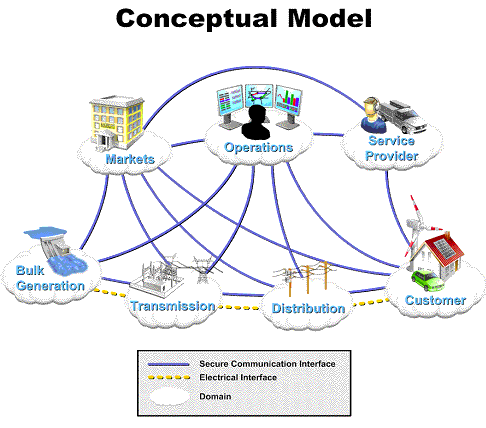Toby Considine
and William Cox co-authored three papers and gave three presentations at
Grid-Interop 2009 in November. In this article we'll discuss the implications for the Smart Grid and
your business of
Architecturally Significant Interfaces of the Smart Grid.
The other two are
Smart Loads and Smart Grids-Creating the Smart Grid Business Case, and
Price Communication, Product Definition, and Service-Oriented Energy. Links to the presentations are
on our web site. While you're at the web site, take a look at our
energy area.
What are the architecturally significant interfaces for the Smart Grid? By analyzing the NIST
Conceptual Model of the Smart Grid (
caution: link is to a 5 megabyte PDF) we see that the inter-domain communications are important, and are moving toward standardization.

Interactions within domains, or to control energy flow, are more mature. Work underway (see the link above to the NIST Priority Action Plans) is addressing major issues with the management of power flows and wide area situational awareness.
But the Smart Grid is more than the Generation, Transmission, Distribution, and Operations domains. To integrate the full range of participants and to reach the promise of the Smart Grid as a system of systems interacting, the Customer, Service Provider, and Markets domains need to work with the domains concerned with energy distributions and management to the Customers.
Markets are the best way to ensure the bringing together and balancing of value, cost, supply, and demand. Customers, aggregators who combine the energy needs and energy supply (generation or curtailment or demand response) need to work with markets.
There is a rich set of interfaces and interactions in calendars and scheduling, geospatial description (GPS and mapping information), weather conditions, and more. The Smart Grid interfaces need to take advantage of and work well with the way we schedule, locate, and describe those things.
Thinking of the Smart Grid actors as service providers (in the general sense, such as Service-Oriented Architectures, rather than simply the Service Provider Domain) lets us take advantage of the flexible interfaces and easy repurposing and evolution from the enterprise software world.
The common interfaces needed are price, product description, and
usage, combined with a means of buying and selling and scheduling and locating. We suggest that the communication of market information that is used to make market decisions is more important for the Smart Grid than interfacing directly with the complexities of markets themselves: think of price quotations rather than the details of how the transactions took place.
The paper goes into more detail on all of these points, and includes over forty references.
We're happy to discuss or answer any questions in a future newsletter or one-on-one. Just call or email.